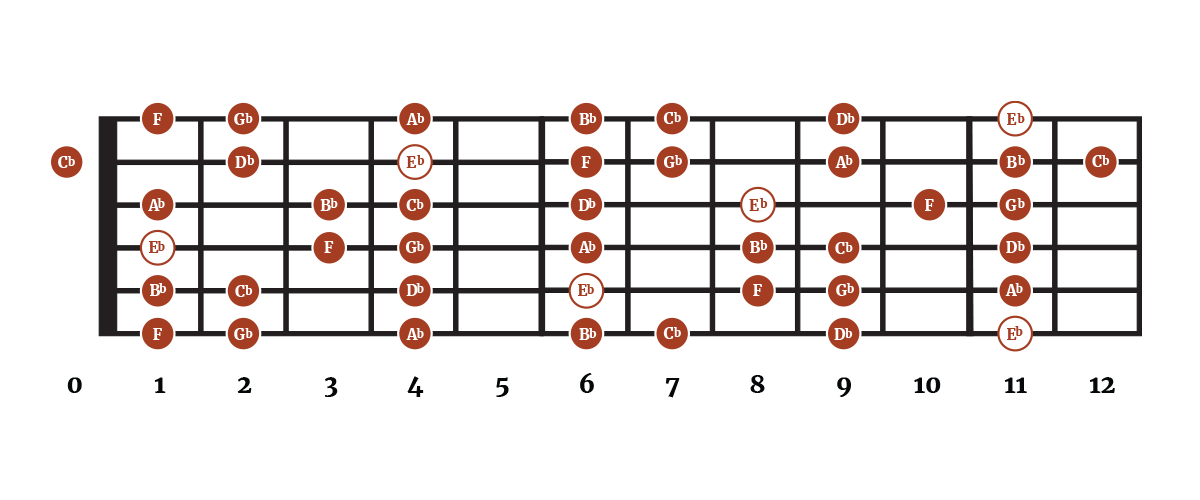The key of F major includes the notes: F – G – A – Bb – C – D – E

When assembled sequentially the notes form the F major scale.
F Major on Guitar
In standard tuning, the tonic chord in the key of F, the F major chord, is typically played using a barre across the first fret, which requires a combination of finger strength and sound technique to avoid buzzing or muted strings.
The key of F is often used by guitarists to experiment with different chord voicings and inversions. Since the F major chord shape can be challenging in standard tuning, guitarists may explore partial chord shapes, open-string drones, or capo positions to create unique sounds and textures within the key of F.
Why is the key of F Major notated using flats instead of sharps?
If notated using sharps instead of flats, we would invariably run into the problem of using the same note letter twice e.g. A, followed by the half step to A#. A rule of thumb when notating scales is not to repeat the same note letter twice within the scale.
The F Major Scale Step Pattern

The F Major scale, like all major scales, follows the familiar pattern of whole, half, whole, whole, whole, half.
Playing The F Major Scale on Guitar
The root F note can be found on the 1st fret of the 6th (E) string. One way to play this scale is to use the caged E shape scale pattern shown below, incorporating open strings.

Chords In The Key Of F Major
All chords constructed from major scales follow the pattern of:
Major, minor, minor, Major, Major, minor, Diminished.
| Maj | min | min | Maj | Maj | min | Dim |
| F | g | a | Bb | c | d | E |
*There are numerous ways to play each of the chords above. The examples shown are just some of the easier voicings for each.
7th Chords in F Major
7th chords add harmonic complexity and depth to music by introducing a fourth note (the 7th note of a key, counted from the root).
Like triads, the quality of a 7th chord is determined by the intervals between its notes.
| Chord | Notes |
| F Major 7 | F, A, C, E |
| G minor 7 | G, Bb, D, F |
| A minor 7 | A, C, E, G |
| Bb Major 7 | Bb, D, F, A |
| C Dominant 7 (C7) | C, E, G, Bb |
| D minor 7 | D, F, A, C |
| E Half-Diminished 7 (Minor 7 Flat 5) | E, G, Bb, D |



You can read more about 7th chords and how to apply them here.
Chord Function
Chords play roles within given keys due to the interplay between the notes that make up the chords, which allows for interesting, and pleasing chord progressions.
For example, the V chord, or dominant chord (Cmaj) plays an important role in this regard, due to its instability. This instability introduces tension which hints, strongly, to us to resolve the tension by returning to the tonic chord (Fmaj) to resolve.
| Tonic | Supertonic | Mediant | Subdominant | Dominant | Submediant | Subtonic |
| I | ii | iii | IV | V | vi | vii° |
| Fmaj | gmin | amin | Bbmaj | Cmaj | dmin | Edim |
You can read more about chord function and the relationship between chords here.
Common Chord Progressions In F Major
| I – V – vi – IV | Fmaj – Cmaj – dmin – Bbmaj |
| I – IV – V | Fmaj – Bbmaj – Cmaj |
| I – vi – IV – V | Fmaj – dmin – Bbmaj – Cmaj |
| I – IV – vi – V | Fmaj – Bbmaj – dmin – Cmaj |
| I – V – vi – iii – IV | Fmaj – Cmaj – dmin – amin – Bbmaj |
Relative Minor

The relative minor key to F Major is Dm minor. D minor contains the same notes as F major, however, the sequence of notes begins on the 6th scale degree of F Major.
D minor
| 1 | 2 | 3 | 4 | 5 | 6 | 7 |
| D | E | F | G | A | Bb | C |














